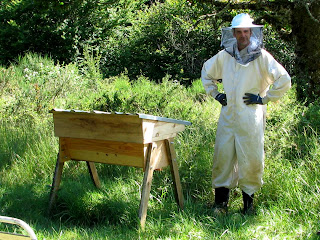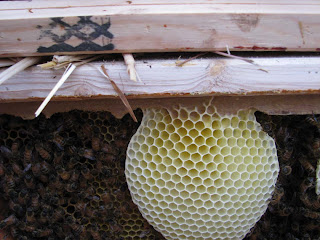I have had to pass the baton of bee hive maintenance to my trusty Homestead partner Buck.
Why? Because I had the lovely surprise this July of getting stung on the face, no big deal in itself. Put some baking soda on it and keep working the hive. So that is what I did, until the unhappy moment when I realized I was having an allergic reaction to the sting.
This realization came almost too late, at the moment in which I was on the phone with my best friend who lives 40 minutes away and realized my hands felt funny and I could not speak coherently.
A 911 call by my friend (that's a real friend indeed) and couple thousand dollars later, I am hesitant to open my hives in my casual style anymore. Not because I am afraid, I remember very little of the incident and so don't really feel fear per say, but everyone who knows me (especially our daughter June), knows they must be very stern with me, and they have.
Because I know that I would be furious with Buck, June and my friend if the tables were turned and they did not take proper precautions in such a situation, I am attempting to do the right thing for them and ultimately for myself.
And so Buck has stepped up to the hive, so to speak and volunteered to be my hands.
Unfortunately it turns out I am not such a good direction giver for dealing with bees. I keep jumping in and grabbing things and barking incomplete orders and then chastising Buck for not doing it right.
It has truly been an exercise in patience for both of us, Buck doing better than me.
The thing is, I am very sad to not be close to my bees. I was having so much fun with them this year. Opening the hive willy-nilly on a warm day and peeking in at my bee kingdom. It was a little like Gulliver's Travels, maybe even to the point of me being taken prisoner, in a kind of abstract way.
Now I suit up and stand ten feet away shouting directions through my bee veil and taking a million pictures with my zoom lens so I can pour over them later.
I am looking into getting a "sting proof" bee suit., but it costs over $200. On one hand I could work with the bees again. On the other hand I don't even want to think about the money I have spent already in the name of bees.
I have a daily internal debate about this. How much is this costing us? How much do we gain from that? Believe me the numbers are not good when you look at them on paper. The bees are not cheap, even if you don't have to include hospital bills in the equation. Sugar is 14.00 a 25 lb. bag. I have gone through 3 of them in one year. Initial costs include hives, hats, gloves, feeders, grease pattie ingredients, classes, several books and the list goes on. What have we gained monetarily from our hives? Zero. Nothing. Nada.
What it comes down to though, for me, is the original and root reason I started a hive: I wanted to increase the pollination of our plants here on the homestead. I wanted to help preserve our country's honey bees in the face of Colony Collapse everywhere. I wanted to make a safe place for bees. Try as I might, I can't really put a price tag on that.
There's an upside to finding out this late in the game that I am allergic to bee stings: I have had a great time with my bees up to now. I have messed with my hives in tank tops and flip flops, captured 4 swarms and started two hives. I've spent countless hours reading, thinking, planning and playing with the bees. If I had known I was allergic before I started all of this, I would have never had the pleasure of being surrounded by bees and being totally in tune with them, being a part of that complex world for a little while and forgetting all of the fear I once had about bees.
I think I
will get that suit and just wear my epi-pen around my neck. When I weigh all the pros and cons, to me it's worth it. But I am sure Buck will insist he is always there with me, sting proof suit or not. And I'm O.K. with that.




















































